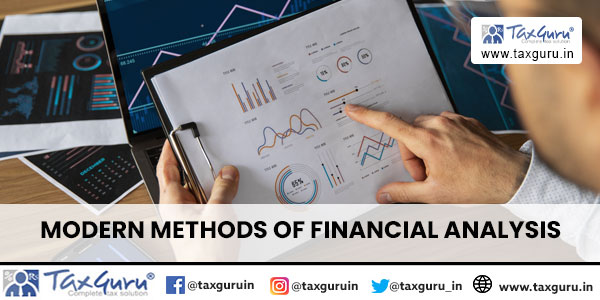Financial analysis is the process of examining financial statements and other relevant data to assess the financial health and performance of an organization. Modern financial analysis uses the advanced technology and tools to analyze, evaluate and interpret financial information. Some of the popular tools and techniques used in modern financial analysis include:
Big Data Analytics: Data analytics converts huge raw data into meaningful actionable information. This involves using statistical, mathematical techniques and computer softwares to analyze large data and identify trends, patterns, and correlations. It makes decision making process easy and more accurate. Data analysis also undertakes sentiment analysis which analyses social media and news sentiments to get insight into market trends and investor behavior
Financial Modeling: This method uses quantitative and mathematical techniques to create models forecasting financial outcomes, such as revenue, income, expenditure, and cash flows. Financial modelling integrates accounting, finance and business metrics to create prediction of a company’s future financial performance. This forecast is based on historical performance and assumptions about the future period.

Cloud-Based Financial Analysis: This involves using cloud-based analytical and computing tools and analysis of financial data, collaborate with stakeholders, and extract new insights to make informed decisions. Cloud computing provides scalable infrastructure for storing, processing, and analyzing large volumes of financial data.
Artificial Intelligence (AI) and Machine Learning (ML): Artificial intelligence will play a major role in contemporary and future analysis techniques. These technologies are being used to automate and speed up financial analysis, data analytics, identify patterns, and make predictions and forecasting. Machine learning, a subset of AI, is a powerful tool to recognize and make predictions based on patterns in data. AI models are able to analyze huge amounts of historical and real time financial data and generate accurate financial projections. These techniques identify subtle trends and patterns in financial data that is very difficult for human beings.
Natural Language Processing (NLP): Natural language processing (NLP) is a subfield of computer science and artificial intelligence (AI) that uses machine learning to enable computers to understand and communicate with human language. NLP algorithms can analyze news articles, financial reports, and social media posts to extract relevant information and sentiment, which can be used for informed investment decision making. NLP is also used for chatbots, voice operated GPS systems, digital assistants such as alexa.
Risk Management Analytics: It is set of various techniques which uses statistical modelling and data analysis to identify, assess, and mitigate financial risks, such as risk to earnings, capital, credit risk, liquidity risk market risk, and operational risk.
Sensitivity Analysis: This refers to analyzing how changes in inputs, assumptions or variables affect financial outcomes, such as revenue, expenses, and cash flows. It studies changes in the output as result of changes in input variables. It helps in decision making and projection of financial outcomes.
Monte Carlo Simulations: Monte Carlo simulations use repeated random samples to estimate possible outcomes of an uncertain event. It is a powerful tool for modeling uncertainty and estimate the probability of various financial outcomes. The main principle of this technique is to use random inputs reflecting uncertainty like real world situation. It is similar to playing game of chance repeatedly to understand the uncertainties.
Real Options Analysis: It is investment appraisal method. This involves using option pricing models to evaluate the value of flexibility and uncertainty in financial decisions in uncertain environments. Various unpredictable variables such as input costs, demand, changes in technology are modeled in this method. A real option is the right but not obligation to undertake a business decision, such as setting up a capital investment project.
Environmental, Social, and Governance (ESG) Analysis: This method evaluates the financial impact of ESG factors, such as climate change, social structure, change of government and corporate governance. It is a framework used to evaluate a company’s performance with reference to environmental, social, and governance factors. It helps investors and other stakeholders understand how a company manages risks and opportunities in various scenarios.
These modern methods and tools enable financial analysts to make more informed decisions, identify opportunities, and mitigate risks. These methods use modern technology to have thorough understanding and interpretation of financial data.





